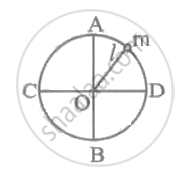Advertisements
Advertisements
प्रश्न
Earth also moves in circular orbit around sun once every year with on orbital radius of 1.5 × 1011 m. What is the acceleration of earth (or any object on the surface of the earth) towards the centre of the sun? How does this acceleration compare with g = 9.8 m/s2?
उत्तर
The orbital radius of the earth around the sun (R) = 1.5 × 1011 m
Time period = 1 yr = 365 day
= 365 × 24 × 60 × 60 s
= 3.15 ×107 s
Centripetal acceleration `(a_c) = Rω^2 = (5pi^2R)/T^2`
= `(4 xx (22/7)^2 xx 1.5 xx 10^11)/(3.15 xx 10^7)^2`
= `5.97 xx 10^-3` m/s2
∴ `a_c/g = (5.97 xx 10^-3)/9.8 = 1/1642`
APPEARS IN
संबंधित प्रश्न
A particle starts from the origin at t = 0 s with a velocity of 10.0 `hatj "m/s"` and moves in the x-y plane with a constant acceleration of `(8.0 hati + 2.0 hatj) ms^(-2)`.
- At what time is the x-coordinate of the particle 16 m? What is the y-coordinate of the particle at that time?
- What is the speed of the particle at the time?
How does uniform circular motion differ from uniform linear motion?
A piece of stone tied at the end of a thread is whirled in a horizontal circle with uniform speed by hand. Answer the following questions:
- Is the velocity of stone uniform or variable?
- Is the acceleration of stone uniform or variable?
- What is the direction of acceleration of stone at any instant?
- Which force provides the centripetal force required for circular motion?
- Name the force and its direction which acts on the hand.
Which of the following graph represents uniform motion of a moving particle?
A small sphere is attached to a cord and rotates in a vertical circle about a point O. If the average speed of the sphere is increased, the cord is most likely to break at the orientation when the mass is at ____________.

A particle is perfonning uniform circular motion. If 'θ', 'ω', 'α' and ' a' are its angular displacement, angular velocity, angular acceleration, and centripetal acceleration respectively, then which of the following is 'WRONG'?
A string of length `l` is fixed at one end and carries a mass 'm' at the other end. The mass is revolving along a horizontal circle of radius 'r' making 'θ' as the semi-vertical angle of cone and `(1/pi)` revolutions per second around the vertical axis through fixed end. The tension in the string is ______.
In uniform motion, an object travels equal ______ in ______ interval of time.
A particle moves along a circle of radius r with constant tangential acceleration. If the velocity of the particle is v at the end of second revolution, after the revolution has started, then the tangential acceleration is ______.
Why is uniform circular motion said to be accelerated?
